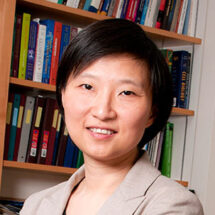
Xiaowei Zhuang will give the 2017 John Kendrew Lecture on Monday 15th January 2018 at 4.00pm in the LMB’s Max Perutz Lecture Theatre. The title of the lecture is ‘Illuminating biology at the nanoscale and systems scale by imaging’. The event is open to anyone in the local area who is interested in attending.
Research in Xiaowei’s laboratory is aimed at developing advanced imaging methods and applying them to problems of biomedical interest. In 2006 Xiaowei and her lab invented STORM (Stochastic Optical Reconstruction Microscopy), one of the first single-molecule-based super-resolution imaging methods. STORM overcomes the diffraction limit using switching and localisation of single fluorescent molecules. They have also invented multiplexed error-robust fluorescence in situ hybridization (MERFISH), a first-in-kind single-cell transcriptome imaging method.
Xiaowei received a BS in Physics from the University of Science and Technology of China, and her PhD in Physics in 1996 from the University of California, Berkeley. She was a postdoctoral researcher at Stanford University working in the lab of Nobel laureate Steven Chu, looking at fluorescence resonance energy transfer (FRET), studying processes such as protein and RNA folding, before moving to Harvard University as an Assistant Professor in the Department of Chemistry and Chemical Biology Department of Physics in 2001. Xiaowei is currently the David B. Arnold Professor of Science and the founding director of the Center for Advanced Imaging at Harvard University. She has also been an investigator at the Howard Hughes Medical Institute since 2005. Xiaowei has received numerous awards for her work. She is a member of the National Academy of Sciences and the American Academy of Arts and Sciences, and a foreign member of the Chinese Academy of Sciences.
Lecture abstract:
Dissecting the inner workings of a cell requires imaging methods with molecular specificity, molecular-scale resolution, and dynamic imaging capability such that molecular interactions inside the cell can be directly visualised. However, the diffraction-limited resolution of light microscopy is substantially larger than molecular length scales in cells, making many sub-cellular structures difficult to resolve. Another major challenge in imaging is the relatively low throughput in terms of the number of molecular species that can be simultaneously imaged, while genomic-scale throughput is desired for investigating many systems level questions. In this talk, I will describe two imaging methods that overcome these challenges and their biological applications. I will first describe stochastic optical reconstruction microscopy (STORM), a super-resolution imaging method that overcomes the diffraction limit. This approach has allowed multicolour and three-dimensional imaging of living cells with nanometer-scale resolution. I will present both technological advances and biological applications of STORM, with focus on some recent discoveries of novel sub-cellular structures enabled by STORM. I will also describe our recently developed single-cell transcriptome imaging method, multiplexed error-robust FISH (MERFISH), which allows thousands of RNA species to be quantified in a spatially resolved manner in individual cells. This approach enables single-cell transcriptomic analysis in the native context of tissues, facilitating the delineation of gene regulatory networks, the mapping of RNA distributions inside cells, and the mapping of distinct cell types in complex tissues. In addition, multiplexed FISH allowed us to trace the folding path of individual chromosomes, which has provided novel insights into the 3D organisation of the genome.
Background information:
The John Kendrew Lecture is named in honour of LMB Nobel Laureate John Kendrew. It is one of a series of named lectures organised by the LMB to be given by eminent scientists from around the world.
John Kendrew was born in Oxford on 24th March 1917. He studied chemistry at Trinity College, Cambridge and graduated in 1939. During World War II he worked on radar for the Air Ministry Research Establishment. In 1946 he returned to Cambridge and joined Max Perutz at the MRC ‘Unit for Research on the Molecular Structure of Biological Systems’ (now the MRC Laboratory of Molecular Biology) where his research focused on protein structure and the X-ray analysis of myoglobin. In the 1960′s John jointly founded the European Molecular Biology Organisation (EMBO) and helped create and was first Director of the European Molecular Biology Laboratory (EMBL). He also founded and was Editor in Chief of the Journal of Molecular Biology. From 1981-1987 he was President of St John’s College, Oxford. He died in Cambridge on 23rd August 1997.
Further references:
Xiaowei Zhuang’s lab page
Poster for the John Kendrew Lecture
John Kendrew biography